It is not myth or secret that most people suffer some type of lower back pain at least one or more times in their life and sometimes its chronic. Now we know that you have heard this before but as exercise physiologists we still hear this day to day and the simple fact is we need to think simply about what we are doing day to day to help with back pain. It seems simplicity is best and watching your posture in activities of daily living and doing a few basic exercise each day could help significantly with your pain.
Dont underestimate the importance of posture
Sitting, standing or lying with poor posture for a few hours may not cause pain initially, but poor posture on a regular basis could even lead to anatomical changes in your spine causing “back pain” in your muscles, discs, and joints. Watching how you sit, stand and lay down by keeping good posture is your first step to reducing or stopping back pain. Try to keep a neutral spine in these positions: this includes walking tall, sitting with support, having an ergonomic work station, sitting with a lumbar support (in car), lifting with a straight back and sleeping with a flat back (not twisted) on your side or back.
What is neutral spine?
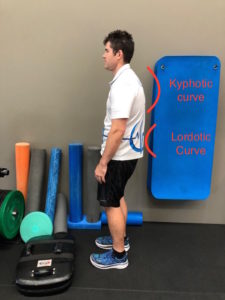
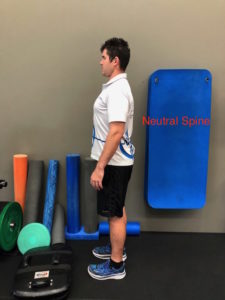
Exercises for back pain
Keeping it simple has been the key with most patients we see in clinic suffering from all types of back pain. The same adage keeps presenting as the main problem: If its too complex, not written down or takes too long then its probably not going to happen. Here are simple exercises in which you can stretch your muscles and move specific joints to alleviate tightness and pressure.
Single knee hug stretch
Lying supine, Keep both knees bent with feet flat on the floor, Bring one knee to chest and grab and hold with both hands, Let the opposite leg drop flat to the floor slowly
Hold for 30 sec
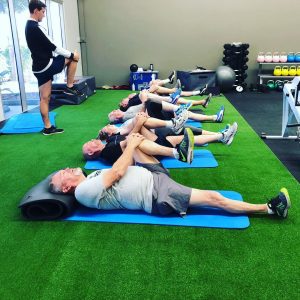
Knee Across / Glut stretch
Lying supine, Keep both knees bent with feet flat on the floor
Put foot up on opposite knee, Hold lead knee with both hands and pull towards opposite shoulder
Hold for 30 sec
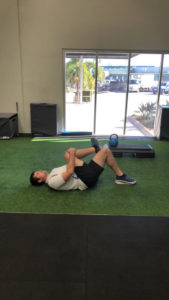
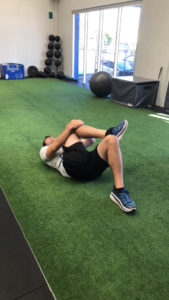
Neural / Leg twist (Sciatic stretch)
Lying supine, Keep both knees bent with feet flat on the floor, Bring one knee to chest and grab and hold with the hand from the same side. Then take your opposite hand an grab the lower portion of your lower leg/shin and gentle pull up towards your head (Slightly twisting the knee joint), Let the opposite leg drop flat to the floor slowly.
Hold for 30 sec
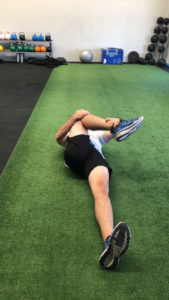
Cat/Camel stretch
Start on your hands and knees with your back in a neutral position. Arch your back, lifting your head up and pushing your tail bone out, making a curve in your lower back.
Next, bend your back up into a arch or bridge by tucking your head and tail bone in and pulling your belly button in towards your spine. Hold this position, and then repeat.
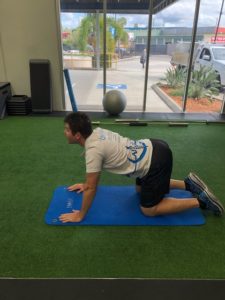
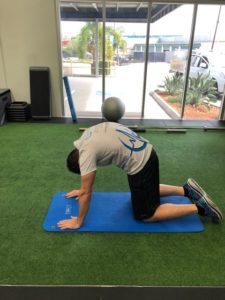
Modified child pose
On all fours, start by widening your knees to hip width or just beyond. Then drop your bum back onto your heels (or towards your heels as far as comfort allows).
Stretch by reaching your hands forwards, dropping your head between your shoulders towards the floor.
Where you should feel it: You will feel this stretch through your upper back, lower back and upper arms.
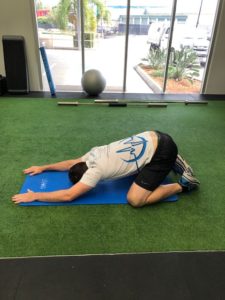
Repeat these exercises 1 to 2 times each in a session that should last approx. 15mins. If you can complete this daily or a minimum of 4-5 times per week for better results.
Back pain can be chronic and sometimes a serious condition. If you have lower back pain or reoccurring back pain and have not sought higher medical advice do not hesitate to talk to your GP about your options. An accredited exercise physiologist can help guide you through your individual needs for reducing symptoms and making sure that you have the tools to self-manage you conditions or injury.
Tim French
AEP, Practice manager
Northside Allied Health
